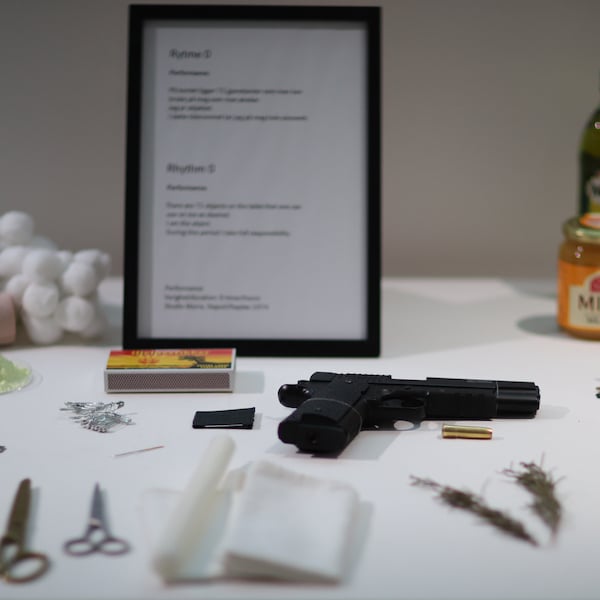
Gallery in the Musée d'art moderne de la ville in Paris (Photo: Flickr [CC BY 2.0])
At the start of the 20th century, Expressionism turned the art world on its head. Spearheaded by German artists aiming to distort reality and “express” emotion, this modernist movement called for bright colors, bold brushstrokes, and energetic compositions. While Expressionism's popularity waned by 1920, it has since sparked several styles and genres, with the Neo-Expressionists—a pack of daring artists—leading the charge.
Learn how this art movement took form in places like France, Germany, and the United States, and its legacy today.
What is Neo-Expressionism?

Andy Warhol, Jean-Michel Basquiat, Francesco Clemente, “Origin of Cotton,” 1984(Photo: Flickr [CC BY-NC 2.0])
With such eclectic source material, it comes as no surprise that Neo-Expressionism manifested as numerous movements around the world, including Neue Wilden in Germany, Transavanguardia in Italy, Figuration Libre in France, and various offshoots in the United States.
Neue Wilden

George Baselitz, “Supper in Dreseden,” 1983 (Photo: Flickr [CC BY-NC 2.0])
“There’s no painting style that does not come from a column, a Mycenaen smile, a broken-off limb,” Lüpertz once remarked. “There are no fine arts that have never been housed in a temple. Every column stump is the beginning of a tree by Munch, which in turn is an arm by Beckmann”
Transavanguardia

Francesco Clemente, “Mother, Lover, Daughter,” 1982 (Photo: Flickr [CC BY-NC 2.0])
Figuration Libre

Robert Combas, “Martin Gale,” 2013 (Photo: Wikimedia Commons [CC BY-SA 4.0])
American Neo-Expressionism

Jean-Michel Basquiat, “Grillo,” 1984 (Photo: Flickr [CC BY-NC-ND 2.0])
A New Spirit in Painting Exhibition
In 1981, work by artists associated with the Neo-Expressionist movement was featured in A New Spirit in Painting, a landmark exhibition at the Royal Academy of Arts in London.
With an emphasis on contemporary trends and a focus on figurative art (“There are outstanding nonfigurative paintings,” the catalog notes, “But we have also decided to omit whole areas of art that are regarded by many today as serious painting”), the show offered the perfect platform for Neo-Expressionists. While curators Norman Rosenthal, Nicholas Serota, and Christos M. Joachimides are credited for launching this “new spirit of painting” into the mainstream, they were criticized for the non-inclusivity of their selections.
Thirty-eight artists (including Neo-Expressionists like Markus Lüpertz, Georg Baselitz, Sandro Chia, and Julian Schnabel, as well as a handful of older big names like Francis Bacon, Willem de Kooning, Andy Warhol, and Frank Stella) were featured in the show. No women were included, revealing the outdated reality of this “new spirit in painting”—and of Neo-Expressionism in particular.
The Legacy of Neo-Expressionism
View this post on Instagram
Today, many major players in the art world have recognized the exhibition's shortcomings—including Norman Rosenthal himself. In fact, in 2018, Rosenthal revisited the seminal exhibition with A New Spirit Then, A New Spirit Now, a show at Almine Rech Gallery in London. While Rosenthal opted to incorporate work by two female artists—Maria Lassnig and Susan Rothenberg—neither of them identify as Neo-Expressionists, illustrating the glaring lack of female artists associated with the movement.
Still, Neo-Expressionism's contributions to contemporary art cannot be overlooked. In addition to revitalizing figurative painting and pushing the boundaries of brushwork and color, critics claim that the movement largely shaped the art world today. “The contemporary art market that exists today,” artist and writer Roger White argues, “its interplay of speculative buying, celebrity culture, and institutional validation, was built on Neo-Expressionism.
Julian Schnabel, however, is less concerned with the movement's role in the bigger picture and more interest in the art itself. “There's been too much attention on marketing,” he said. “Can't we just talk about the paintings?”
Related Articles:
Bauhaus: How the Avant-Garde Movement Transformed Modern Art
Precisionism: The Modern American Style Sparked by Industrialization
10 of the Best Contemporary Art Museums to Visit Around the World
25 Art History Terms to Help You Skillfully Describe a Work of Art






















































































